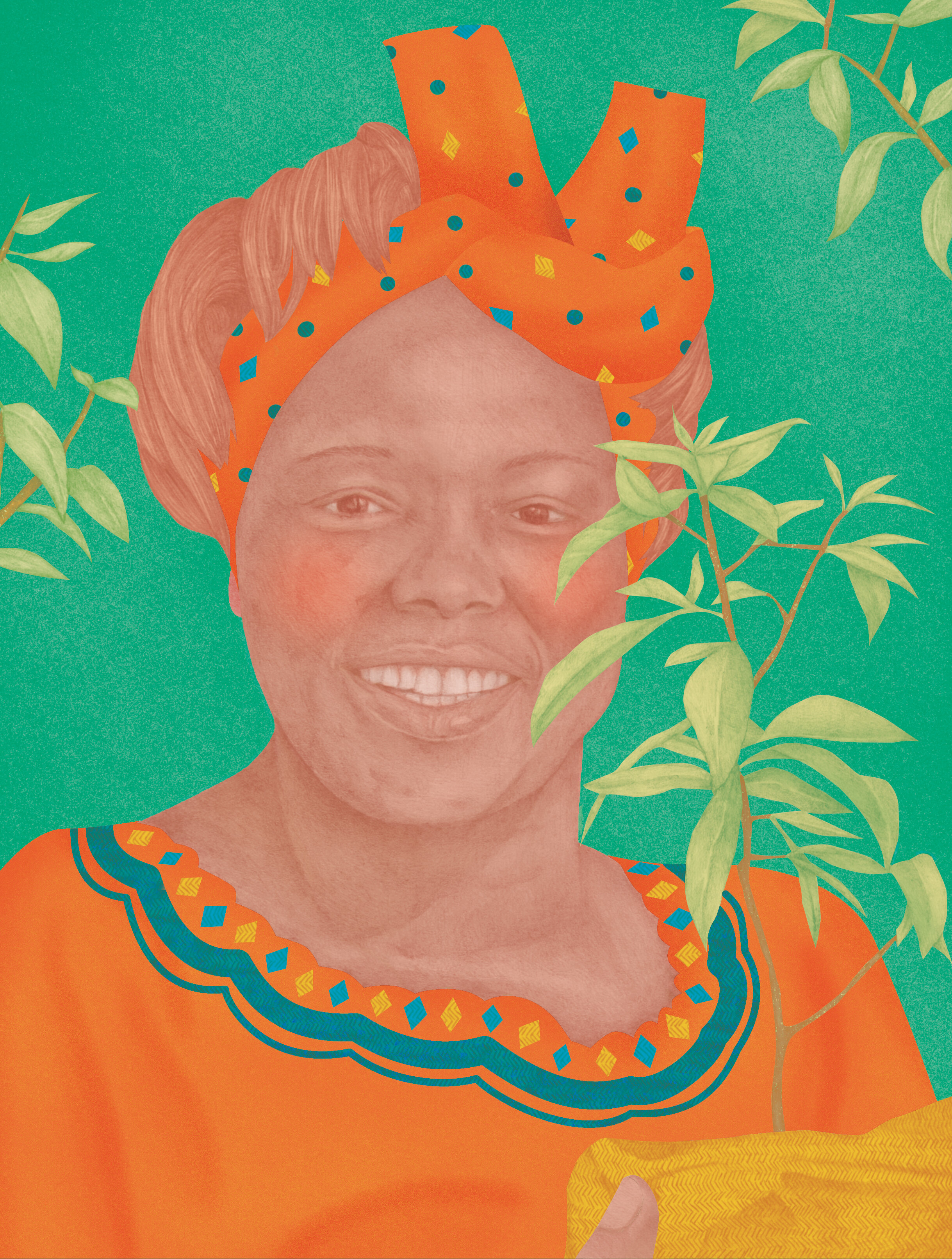The following is a sample profile from the book Holy Troublemakers & Unconventional Saints by Daneen Akers.
Wangari Maathai
Wangari Maathai was the first at a lot of things. A biologist, she was the first woman in Central Africa to earn a Ph.D. She was the first woman to be the head of an academic department at the University of Nairobi. She was the first woman to hold the job of Minister of the Environment in Kenya. And, in 2004, she became the first African woman to receive a Nobel Peace Prize.
Wangari’s story begins in Ihithe, a small village in Kenya’s highlands where she was born in 1940. Wangari’s parents had converted to Christianity, and they were part of the Kikuyu tribe, one of the main Indigenous people groups who live in Kenya. Indigenous means someone who is native to a region, that their families and ancestors who came before them lived on and loved the land.
Although Wangari grew up Catholic, her family’s traditional Kikuyu beliefs still informed how they lived and thought about God. The Kikuyu believe that God, called “Ngai” in the Kikuyu language, dwells on Mount Kenya, the second tallest mountain on the African continent. The Kikuyu built their homes to face Mount Kenya, which reminded them daily where all good things come from.
Illustration by Debora Guidi
Nearer the ground is the Mugumo tree, a type of fig tree and seen as one of God’s sacred trees.
Every morning as a child, Wangari collected firewood for her family. She could collect wood from any tree except from the Mugumo tree. They left these trees alone, because, as her mother explained, “This is a tree of God. We don’t collect wood from this tree.” These fig trees lived a long and natural life.
Later, as a trained biologist, Wangari realized that those sacred fig trees played a central role in the ecology of the land. Because the Mugumo trees were sacred and allowed to live long lives, their roots grew deep into the bedrock below the surface of the earth. The roots cut into the rock and allowed subterranean water to flow up close to the surface. Their vast root systems also stabilized the soil, protecting the region from landslides.
But, when Wangari went away to university and graduate school, the lands where she grew up underwent a major change. Trees—even the sacred trees—were cut down to make room for large farms and other development. Not only did this destabilize the soil, but the farms often polluted the water sources, so women and girls had to walk long distances to find clean water, and these long walks were dangerous.
In 1977, at the first ever United Nations meeting on women’s rights, Wangari heard the stories of these women, and she realized something had to be done. While the problem was complicated, she knew one small, tangible step that would add up to a big difference: “I think we should plant trees,” she told the assembly.
She received some quizzical looks. Not everyone knew what she knew about trees and the land. That was okay, she decided, they’d learn. That was the birth of the Green Belt Movement, an organized effort to plant trees led mostly by poor, rural Kenyan women. Unfortunately, politicians and developers opposed the women who planted trees, and tried to stop them at every turn.
“Planting trees is a kind of ecological form of civil disobedience,” Wangari later reflected. She faced all kinds of resistance from the politicians in charge who only wanted economic development, the kind of development that would lead to their own pockets being lined with money. She was called names, put into prison, and even beaten.
But Wangari kept planting trees. The first year, Wangari only planted seven trees, and five of those seedlings died. But the two remaining trees are still alive today. And collectively, Wangari and the many women who joined her have now planted over 51 million trees in Kenya and many other countries.
In Kenya, a tree is a sign of peace, so it’s especially fitting that Wangari received the Nobel Peace Prize on behalf of her work. In her acceptance speech, she explained that many conflicts around the world are actually caused by ecological crises. Planting trees and paying attention to the balance in nature helps reduce major conflicts that often turn violent.
“When we plant trees, we plant the seeds of peace and hope,” she said.
What are ways you could help make peace by taking care of the earth?
Glossary Terms
Catholic
A person who is a member of the oldest and largest Christian church. Until the Protestant Reformation in the 16th century, the Roman Catholic Church was the only Christian church; it formed after the Roman Emperor Constantine declared Christianity the official religion of the empire in 313 AD and demanded conformity of beliefs among the various Christian groups and a highly organized church structure.
Christian/Christianity
A person who practices Christianity, the Abrahamic Religion based on the teachings of Jesus, a first-century Jewish teacher. While there are many different types of Christians who vary widely in belief and practice, all find the life and teachings of Jesus to be of central importance.
Civil Disobedience
The act of refusing to obey certain laws as a form of peaceful protest.
Ecological/Ecology
The relation of all living things (including bacteria, plants, animals, and human beings) to one another and their physical surroundings.
Indigenous
The original or Native people in a region or country. Indigenous people are descended from the original inhabitants of the land they live on. In the U.S., Indigenous people are usually called “Native Americans.” In Canada, they are called “First Nations” people. Today there are an estimated 370 million Indigenous people in 90 countries who speak 7,000 languages.
Nobel Peace Prize
A major prize awarded annually for “outstanding contributions in peace;’’ famous recipients include Malala Yousafzai, Barack Obama, and Jimmy Carter.
Ph.D.
A doctorate, or the most advanced university degree one can earn in any field except medicine.
United Nations
An international organization that attempts to maintain peace and positive relations among nations around the globe.
Read another sample chapter from the Holy Troublemakers & Unconventional Saints book by Daneen Akers.



